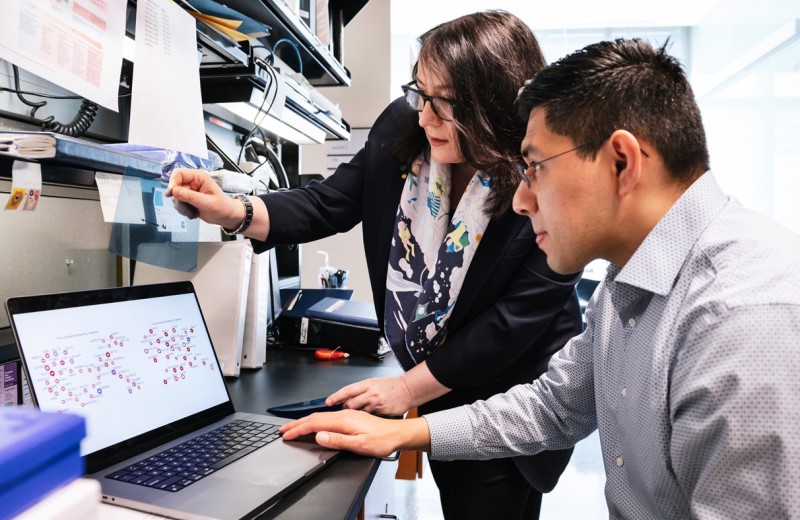Gladstone NOW: The Campaign Join Us on the Journey✕

Dr. Eric Verdin's research on the immune system has revealed a potential new treatment for autoimmune disorders like multiple sclerosis and type I diabetes. [Photo: Chris Goodfellow]
Scientists from the Gladstone Institutes have discovered a way to prevent the development of multiple sclerosis (MS) in mice. Using a drug that blocks the production of a certain type of immune cell linked to inflammation and autoimmunity, the researchers successfully protected against the onset of MS in an animal model of the disease. The scientists say the next step is to test this strategy using other autoimmune disorders.
“We are very excited about these findings,” says Eric Verdin, MD, a senior investigator at Gladstone and co-senior author on the study. “In light of the significant effect the treatment had on inflammation, the implications of these results will likely extend beyond multiple sclerosis to other types of autoimmune disorders. We are particularly interested in testing this in type I diabetes given the similar pathways involved, and we are already seeing very promising results in preliminary experiments.”
In the immune system, two kinds of T cells strike a delicate balance—T helper cells (Th17) activate the immune system, protecting against infections and cancers, while regulatory T cells (Tregs) suppress the system, keeping it in check. A disparity between these cell types, when there are too many Th17 and not enough Tregs, can lead to a hyperactive immune system, resulting in inflammation, tissue damage, and autoimmune disease. In the current study, published in the Journal of Experimental Medicine, the researchers discovered that an important regulatory protein, sirtuin 1 (SIRT1), is involved in the production of Th17 cells. By blocking this protein, the scientists can protect against the onset of autoimmunity. SIRT1 also has a negative impact on Treg maturation and maintenance, so inhibiting its expression simultaneously enhances the production of Tregs and suppresses the creation of Th17.
To test this effect on disease, the researchers used a mouse model of MS and treated the animals with a drug that inhibits SIRT1. Typically, MS-model mice experience severe motor problems, eventually leading to paralysis, but when they were given the drug the mice behaved perfectly normally. Moreover, the treated animals showed no signs of inflammation or cell damage in their spines, classic markers for MS.
In contrast with the current research, SIRT1 is typically thought of as having anti-inflammatory properties, and compounds that increase SIRT1—like resveratrol—have been proposed as a way to delay aging. However, first author Hyungwook Lim, PhD, a postdoctoral fellow at Gladstone, says the new research suggests that the protein’s effects are more complicated.
“The conventional theory has been that you should activate SIRT1 to improve health and longevity, but we show that this can have negative consequences,” says Dr. Lim. “Instead, we think the role of SIRT1 very much depends on the type of tissue being targeted. For instance, in immune cells, instead of being anti-inflammatory SIRT1 appears to have a pro-inflammatory role, which makes it a prime target to treat autoimmune disorders.”
Meet Gladstone: Julia Kaye
Meet Gladstone: Julia Kaye
Julia Kaye is a neuroscientist at Gladstone Institutes dedicated to unraveling the mysteries of neurodegenerative diseases. Outside the lab, Kaye enjoys skateboarding, surfing, and exploring nature with her family.
Profile ALS Huntington’s Disease Multiple Sclerosis Neurological Disease KayeA New Era of Treating Neurological Diseases at the Blood-Brain-Immune Interface
A New Era of Treating Neurological Diseases at the Blood-Brain-Immune Interface
Gladstone scientists say it’s time to think differently about how to define and treat diseases such as Alzheimer’s and multiple sclerosis.
News Release Research (Publication) Alzheimer’s Disease Dementia Multiple Sclerosis Parkinson’s Disease Neurological Disease Akassoglou LabRevealing How Blood Triggers Brain Disease
Revealing How Blood Triggers Brain Disease
New research into how blood makes the brain’s immune cells toxic points to new treatments for Alzheimer’s disease and multiple sclerosis
News Release Research (Publication) Multiple Sclerosis Alzheimer’s Disease Center for Neurovascular Brain Immunology Neurological Disease Akassoglou Lab Krogan Lab Pico



